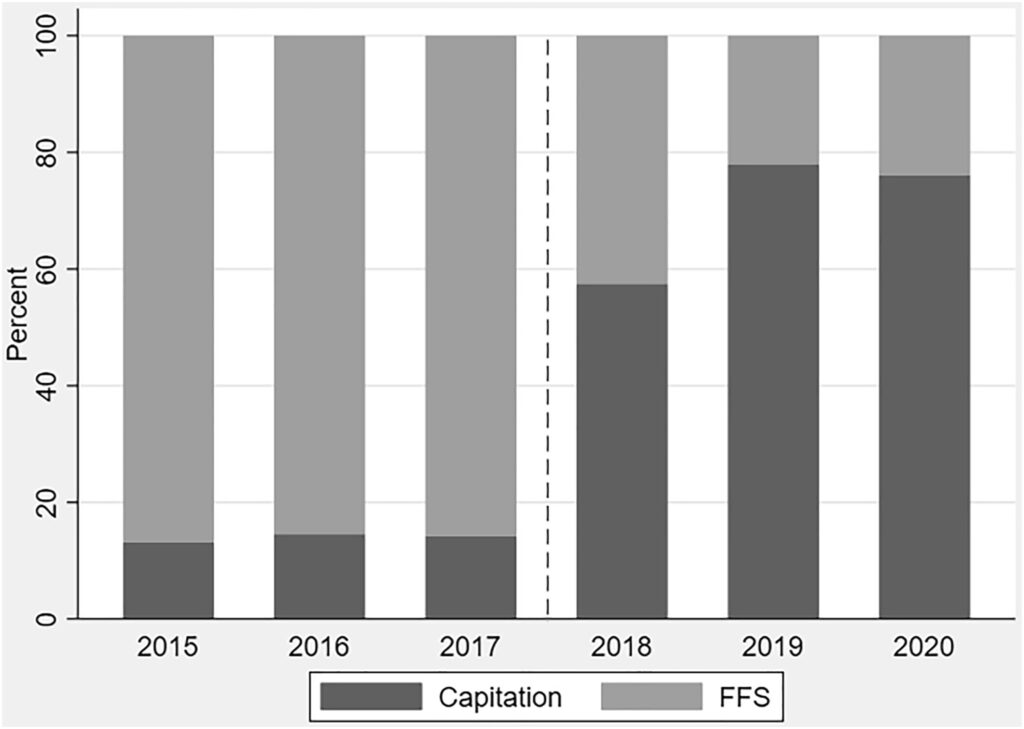
[ad_1]
There was a lot analysis displaying that fee-for-service (FFS) results in elevated provision of medical companies and capitation results in decreased provision of medical companies. My very own analysis exhibits that there are system-wide results and that the impression of capitation for major care physicians on companies could rely upon whether or not specialists are additionally reimbursed by way of fee-for-service. Nevertheless, it isn’t clear how growing the proportion of reimbursement that’s capitated impacts well being care service provision. This is a vital for quite a lot of causes. First, CMS is more and more shifting to various fee fashions which can be wanting increasingly like capitation. Second, a big share of well being care provision within the US is beneath combined reimbursement schemes. Third, reimbursement kind varies throughout nations; or occasion, in in Norway and Denmark, FFS accounts for 70%–80% of the full reimbursement however within the household well being group scheme in Ontario, Canada, FFS half covers solely 10% of reimbursement.
To look at this query, a paper by Skovsgaard et al. (2023) makes use of a change to normal practitioner reimbursement in Denmark 2018, particularly for treating sufferers with Kind 2 diabetes. The precise adjustments had been as follows:
The brand new lump-sum capitation for sufferers with kind 2 diabetes was set at DKK 2045 (approx. US$ 280) per affected person per 12 months along with the essential lump-sum capitation per affected person. This quantity was greater than the corresponding common FFS which had been discontinued for sufferers with kind 2 diabetes. Discover that the capitation changed FFS for all contacts for sufferers with kind 2 diabetes, not solely contacts associated to diabetes. The remaining FFS charges outdoors the reform comprise a spread of supplementary companies together with guideline-recommended monitoring of HbA1c, influenza vaccination and checks for microalbuminuria by assessing protein in urine. These guideline-recommended companies are course of high quality measures which point out if adjustments in service provision impacts high quality of care

https://onlinelibrary.wiley.com/doi/full/10.1002/hec.4736
When it comes to empirical technique, the authors carry out a distinction in-difference strategy. The pre-post is variations between the outcomes and curiosity earlier than and after an annual management go to. The change in companies is examined for annual management visits in 2018-2019 as in comparison with 2015-2016. The outcomes or curiosity had been: (i) variety of visits (in-person, telephone and electronic mail), (ii) variety of diabetes-related lab checks (e.g., urine sticks, and HbA1c checks), (iii) flu vaccinations, (iv) supplemental companies associated to diabetes, and (v) supplemental companies not associated to diabetes.
Utilizing this strategy, authors discover that:
The impact of enrolling a affected person within the new scheme is unfavourable with a discount of round 2% as in comparison with the baseline worth (ATT = −0.27%; −1.9%)…the impact of enrollment on supplementary companies (s) associated to diabetes pointers is unfavourable at a magnitude of round 4% discount as in comparison with baseline (ATT = −12.29%; −4.4%)…The outcomes [also] point out reductions 5.0%, 5.4%, and 4.2% as in comparison with baseline for urine sticks, blood pattern, and affect vaccination, respectively.
To confirm the robustness of their findings, the authors checked out companies not included within the new reimbursement scheme (e.g., lipid reducing drugs) and located no impact for this placebo take a look at.
The authors hypothesize that the rationale the reductions in supplemental companies had been bigger in magnitude than the discount in visits was due to a substitution away from face-to-face visits towards telephone and electronic mail contacts that do now permit for rapid provision of supplemental companies.
You may learn the total paper right here.
[ad_2]